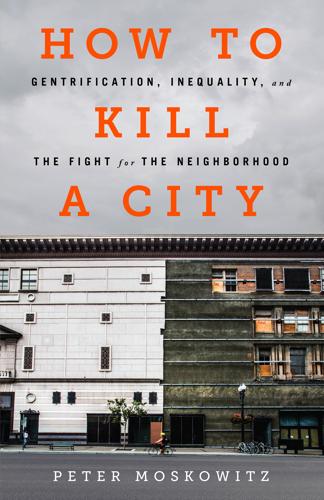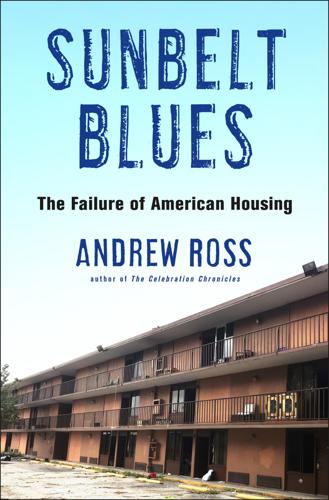rent gap
description: theory that capital flows to the rate of highest return, and return is highest after a city has been economically drained and primed for gentrification
9 results

How to Kill a City: The Real Story of Gentrification
by
Peter Moskowitz
Published 7 Mar 2017
“People can say whatever they want about these rich people coming in and doing this that and the other, but I was comfortable down there,” Robinson continued. “I wanted to stay there. And they kicked me out.” The rent-gap theory—that capital flows to the rate of highest return, and return is highest after a city has been economically drained and primed for gentrification—explains the economic rationale behind the new Detroit. Detroit has been in decline for decades, but its bankruptcy in 2013 put it in position for a rent-gap rebound: not only was the city broke, but it was now run by an emergency manager named Kevyn Orr, who was intent on slashing city services and making the city more palatable for investment.
…
Sure, they could buy land even farther from the city and attempt to develop it, but commuters are only willing to travel so far, and New York’s suburban commute times were already pushing the hour mark. The city, on the other hand, was a bargain, thanks to white flight and deindustrialization. In 1979, geographer Neil Smith came up with what has become possibly the most influential academic theory on gentrification: the rent gap. Smith posited that the more disinvested a space becomes, the more profitable it is to gentrify. The idea behind his theory is a basic tenet of free-market economics: capital will go where the rate of potential return (i.e., the potential to make profit) is greatest. Smith realized that gentrification wasn’t happening at random.
…
If you wanted to find the neighborhood that would gentrify next, all you had to do was figure out where the biggest potential for profit was in a city—the place where buildings could be bought cheap and made more expensive in a short period of time. By looking at tax data, Smith could pinpoint blocks that seemed to be gentrifiable, which usually meant buildings were in disrepair (so they could be bought cheap) and were close to other gentrified areas (so it wouldn’t be too much of a stretch for gentrifiers to move in). The rent gap was the disparity between how much a property was worth in its current state and how much it would be worth gentrified. The larger the gap in a neighborhood, the higher the chance it would gentrify. Gentrification might seem rapid when you’re in a neighborhood experiencing it firsthand, but it’s really a long game: real estate developers (at least the smart ones) know they can benefit from the vast, decades-long shifts that happen in metropolises.

Big Capital: Who Is London For?
by
Anna Minton
Published 31 May 2017
He argues that when that gap becomes big enough, developers become interested and private capital flows in, attracted by the potential to make large profits.25 Academics have claimed that the failure to maintain estates, which keeps prices low, contributes to a ‘state-induced rent gap’.26 When he talks of local authorities adapting to the ‘potential’ for market-priced development, Adonis himself is clear that the ‘rent gap’ offered by potentially very high land values is driving estate regeneration. He argues that at a time of acute housing crisis, redevelopment is the only way to build the numbers of houses required, as the sales of new expensive homes also help pay for new affordable homes.
…
Since 2004, Channel 4’s long running ‘ident’ – identity logo – has been taken from the Aylesbury, with grainy black and white footage shown panning across rubbish-strewn balconies, while the concrete structures shift into place to form the Channel 4 logo; except that, unbeknown to viewers, the washing lines, shopping trolleys, rubbish bags and satellite dishes were never really there23 – they were added in as props by the film makers to make it look as dystopian as possible. While most people watching wouldn’t know the images of decay are from the Aylesbury, the local community certainly does. THE ‘RENT GAP’: FROM SOCIAL HOUSING TO SUPER PRIME I’ve put the bulldozing of sink estates at the heart of turnaround Britain. David Cameron, Sunday Times, 10 January 2016 In this piece in the Sunday Times, which launched the former prime minister’s ‘Sink Estates’ initiative, Cameron stuck carefully to the by now familiar story of estate failure: There is one issue that … for me, epitomises both the scale of the challenge we face and the nature of state failure over decades.
…
Borough by borough, a city village programme, centred on systematic estate regeneration, is required.’ So it is clear that if these plans are even partially realized they will completely alter the social make-up of London. This policy – of redeveloping estates – is driven by American academic Neil Smith’s concept of the ‘rent gap’, which he developed as a different way of looking at gentrification. The model favoured since the 1970s maintained that the middle classes moved back to the post-industrial city attracted by new economic opportunities and lifestyle as the former spaces of industry opened themselves up to trendy loft living.

There Is No Place for Us: Working and Homeless in America
by
Brian Goldstone
Published 25 Mar 2025
Because investors have identified a “rent gap,” as geographer Neil Smith terms it. This gap represents the difference between the current value of land and the higher returns it could yield through some intervention, such as renovating a property, demolishing and constructing new buildings, or evicting old tenants and attracting different ones. The wider the rent gap, the stronger the incentive for investment. Factors such as proximity to green space, transportation, and other amenities may contribute to its emergence, but the primary drivers of the rent gap are shifts in urban policy and market demand.
…
GO TO NOTE REFERENCE IN TEXT the intertwined interests of real estate capital and urban policy: Samuel Stein, Capital City: Gentrification and the Real Estate State (London: Verso, 2019). GO TO NOTE REFERENCE IN TEXT The wider the rent gap: Neil Smith, “Gentrification and the Rent Gap,” Annals of the Association of American Geographers 77, no. 3 (September 1987): 462–65; see also Tom Slater, “Planetary Rent Gaps,” Antipode 49, no. 1 (September 22, 2015): 114–37. GO TO NOTE REFERENCE IN TEXT Urban planners—increasingly concerned with growth: Nikil Saval, “The Plight of the Urban Planner,” The New Yorker, November 20, 2019.
…
Urban planners—increasingly concerned with growth, and so beholden to the priorities of developers and investors—play a critical role not only in creating rent gaps where none previously existed but in helping landlords and property owners exploit them. In this way, gentrification becomes a political process as much as a social and economic one: an outcome of zoning changes and tax abatements, infrastructure upgrades and public-private partnerships. In Atlanta, no single project has more profoundly reshaped the urban landscape than the BeltLine—arguably the greatest rent-gap generator in the city’s history, and a prime example of planned gentrification. This transformative endeavor, winding through forty-five neighborhoods and redefining Atlanta’s core, epitomizes the interplay between city governance, urban planning, and real estate interests.

After the Gig: How the Sharing Economy Got Hijacked and How to Win It Back
by
Juliet Schor
,
William Attwood-Charles
and
Mehmet Cansoy
Published 15 Mar 2020
Abrahao et al. (2017). 30. Ayres, Banaji, and Jolls (2015); Nunley, Owens, and Howard (2011). 31. Mehmet’s detailed findings are contained in his PhD dissertation, “ ‘Sharing’ in Unequal Spaces” (Cansoy 2018), and various papers, such as “Gentrification and Short-Term Rentals: Re-assessing the Rent Gap in Urban Centers” (Cansoy 2019a); “The Fault in the Stars: Public Reputation and the Reproduction of Racial Inequality on Airbnb” (Cansoy 2019b); and “Who Gets to Share in the ‘Sharing Economy’: Understanding the Patterns of Participation and Exchange in Airbnb” (Cansoy and Schor 2019). For pioneering research on Airbnb also using scraped data, see Slee (2015) and the work of Murray Cox, who posts research on the website Inside Airbnb, http://insideairbnb.com. 32.
…
“The Rise of Algorithmic Work: Implications for Managerial Control and Career Pathways.” Unpublished paper. University of Michigan. Cansoy, Mehmet. 2018. “ ‘Sharing’ in Unequal Spaces: Short-Term Rentals and the Reproduction of Urban Inequalities.” PhD diss., Boston College. ———. 2019a. “Gentrification and Short-Term Rentals: Re-assessing the Rent Gap in Urban Centers.” Unpublished paper. Boston College. ———. 2019b. “The Fault in the Stars: Public Reputation and the Reproduction of Racial Inequality on Airbnb.” Unpublished paper. Boston College. Cansoy, Mehmet, and Juliet B. Schor. 2019. “Who Gets to Share in the ‘Sharing Economy’: Understanding the Patterns of Participation and Exchange in Airbnb.” www.bc.edu/content/dam/files/schools/cas_sites/sociology/pdf/SharingEconomy.pdf.
…
“The Impact of New Short-Term Rental Regulations on New York City.” Montreal: Urban Politics and Governance Research Group, School of Urban Planning, McGill University. www.sharebetter.org/wp-content/uploads/2019/01/Impact-of-New-STR-Regs-2019.pdf. Wachsmuth, David, and Alexander Weisler. 2018. “Airbnb and the Rent Gap: Gentrification through the Sharing Economy.” Environment and Planning A: Economy and Space 50 (6): 1147–70. Walker, Edward T. 2016. “Between Grassroots and ‘Astroturf’: Understanding Mobilization from the Top-Down.” In The SAGE Handbook of Resistance, edited by David Courpasson and Steven Vallas, 269–79.

Born in Flames
by
Bench Ansfield
Published 15 Aug 2025
Cities,” Newark Star-Ledger, November 1, 1976. Gelvin Stevenson, “Upsurge in Arson Calls for Insurance Reform,” New York Times, September 11, 1977. 24I am borrowing here from Neil Smith’s rent gap theory of gentrification. In a paradigm-shifting 1979 essay, Smith defined the rent gap as “the disparity between the potential ground rent level and the actual ground rent capitalized under present land use” (545). “Once the rent gap is wide enough,” he argued, “gentrification may be initiated.” Neil Smith, “Toward a Theory of Gentrification: A Back to the City Movement by Capital, Not People,” Journal of the American Planning Association 45, no. 4 (1979): 538–48. 25Deborah Stone, “Beyond Moral Hazard: Insurance as Moral Opportunity,” in Embracing Risk: The Changing Culture of Insurance and Responsibility, ed.
…
See insurance redlining; mortgage redlining refinancing, cash-out, 64 reinsurance, 31, 36–41, 93, 126, 135, 137, 140–43, 145, 148–50, 153, 154, 156, 158, 211, 249, 256, 257; see also riot reinsurance Reinvestment Committee (Northwest Bronx Community and Clergy Coalition), 251–52 reinvestment movement, 249–53, 256, 259 Renigades, 229 Reno, Nevada, 7 renovations, 27, 28, 55, 229, 230, 232, 233, 234, 239, 246 rent control, 9, 50, 63–64, 84, 128, 208, 231 rent gap, 298 rent strikes, 183, 218, 231 renter’s insurance, 28, 287 replacement cost, 298 Report from Engine Co. 82 (Smith), 125 residual market, 26–27, 38–41, 56, 57, 59, 119, 147, 206, 251–52, 256–58 Reyes, Raoul, 232 Rhode Island, 43 Richmond, Virginia, 7 Rio de Janeiro, Brazil, 136, 145, 149, 158 riot insurance, 34–35 riot reinsurance, 12, 22, 35–40, 44, 226, 248, 249, 254 “riot-affected areas,” 21, 37, 41, 42, 58–59, 257 “riot-prone areas,” 22, 41–42, 45, 57, 59, 75, 137, 188, 293, 321 “risk communities,” 86 Rivera, Virginia, 79 Rivers, Darney “K-Born,” 109, 115 Rivieccio, Anthony, 102, 103 Robbins, Idaho, 99 Roberts, A.

Our Lives in Their Portfolios: Why Asset Managers Own the World
by
Brett Chistophers
Published 25 Apr 2023
Note that this data point corresponds closely to reported figures for geographic shares of real-estate AUM more widely: BCG estimated that, in 2020, 69 per cent of real-estate AUM were held by asset managers headquartered in North America, ahead of managers based in Europe (18 per cent) and the Asia-Pacific region (12 per cent). See BCG, ‘$100 Trillion Machine’, p. 18. 52 GK1. 53 H. Vogell, ‘When Private Equity Becomes Your Landlord’, 7 February 2022 – at propublica.org. 54 GK1. 55 GK2, pp. 35–7; B. Christophers, ‘Mind the Rent Gap: Blackstone, Housing Investment and the Reordering of Urban Rent Surfaces’, Urban Studies 59 (2022), pp. 698–716. 56 See, for example, M. Janoschka, G. Alexandri, H. Ramos and S. Vives-Miró, ‘Tracing the Socio-Spatial Logics of Transnational Landlords’ Real Estate Investment: Blackstone in Madrid’, European Urban and Regional Studies 27: 2 (2020), pp. 125–41; I.
…
Kohl, ‘My Home Is an Asset Class: The Financialization of Housing in Europe’, 2021 (pre-publication version). 33 Ibid. 34 G. Hammond, ‘Greystar Raises Fresh Funds as Residential Rental Investment Surges past €30bn’, Financial Times, 7 July 2022. 35 A. Carroll, ‘A New Balance for Real Estate’, PERE, 14 April 2022 – at perenews.com. 36 Ibid. 37 Cited in B. Christophers, ‘Mind the Rent Gap: Blackstone, Housing Investment and the Reordering of Urban Rent Surfaces’, Urban Studies 59 (2022), p. 709. 38 The US case is interesting. It is true, as we saw in Chapter 4, that various congressional committees have recently investigated, and been critical of, the operations of large US residential landlords including those controlled by asset managers – focusing in particular on eviction practices during the coronavirus pandemic.

The New Tourist: Waking Up to the Power and Perils of Travel
by
Paige McClanahan
Published 17 Jun 2024
Evidence from Airbnb in Barcelona,” Journal of Urban Economics 119 (September 2020): 103278. 16 Anne-Cécile Mermet, “Who Is Benefiting from Airbnb? Assessing the Redistributive Power of Peer-to-Peer Short-Term Rentals,” Professional Geographer 73, no. 3 (2021): 553–66. 17 Alberto Amore, Cecilia de Bernardi, and Pavlos Arvanitis, “The Impacts of Airbnb in Athens, Lisbon and Milan: A Rent Gap Theory Perspective,” Current Issues in Tourism 25, no. 4 (April 2020): 3329–42. 18 Dustin Robertson, Christopher Oliver, and Eric Nost, “Short-Term Rentals as Digitally-Mediated Tourism Gentrification: Impacts on Housing in New Orleans,” Tourism Geographies 24, no. 3 (May 2022): 954–77. 19 Kyle Barron, Edward Kung, and Davide Perserpio, “The Effect of Home-Sharing on House Prices and Rents: Evidence from Airbnb,” March 4, 2020, https://ssrn.com/abstract=3006832 or http://dx.doi.org/10.2139/ssrn.3006832.

Sunbelt Blues: The Failure of American Housing
by
Andrew Ross
Published 25 Oct 2021
Today, the ambition of the 1949 act is carried on by the housing justice movement, with its renewed focus on renter rights, tenant organization, and the rallying cry of “Homes for All.”10 THE DIFFERENT FACES OF A CRISIS Although it is national in scope, the US housing crisis looks quite different from place to place. Housing markets are intensely local, so pricing and rent gaps can vary greatly even within a single metro area, and even more so between them: consider the great disparity in housing affordability between, say, Boston and Detroit, or between space-starved cities in the Frostbelt and those in the Sunbelt regions with room still to spread out. In strong metro markets, like Austin or San Diego, homeownership is increasingly out of reach for middle-income earners.

Rentier Capitalism: Who Owns the Economy, and Who Pays for It?
by
Brett Christophers
Published 17 Nov 2020
The UK’s mobile operators have been geographically selective in building out their networks, cherry-picking densely populated hot-spots. In sparsely populated rural areas (the so-called ‘not-spots’ without coverage), the subscriber rents potentially available from service provision simply do not justify the necessary infrastructure investment. Think of it as another type of ‘rent gap’. Like financial rentiers, infrastructure rentiers are exclusionary. To paraphrase Joan Robinson, from a consumer’s perspective the only thing worse than paying rent to a rentier is not even having the opportunity to do so. The second set of criticisms, meanwhile, relates to fixed-line services, and more specifically to BT.